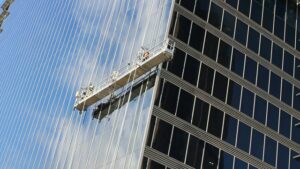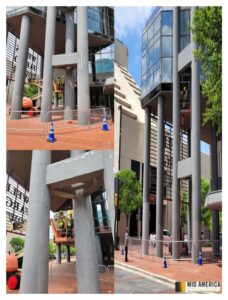
A building’s facade is its “face to the world” — the first thing visitors, tenants, and passersby see. Over time, exposure to weather, pollution, and structural stresses can degrade that face, undermining both aesthetics and performance. Facade restoration is the systematic process of evaluating, repairing, cleaning, and protecting a building’s exterior, ensuring it fulfills functional needs while projecting a strong visual presence.
In this post, we’ll walk through the typical restoration process, explore its many benefits (from weather protection to curb appeal), and highlight how expert firms like MASS (Mid America Specialty Services) help deliver both beauty and resilience.
The Facade Restoration Process — Step by Step
A well-executed facade restoration typically follows a multi-stage process. While specifics vary by material (brick, stone, metal, glass, stucco, etc.), the broad phases below are common across many projects.
1. Assessment & Diagnostics
- A detailed survey is carried out to identify areas of deterioration: cracked or spalled masonry, failing mortar, corroded metal, water intrusion paths, delamination of coatings, and more.
- Non-destructive testing (e.g. infrared, moisture scanning) may be used to detect hidden damage behind finishes.
- The survey results inform a restoration plan, detailing what must be conserved, replaced, or protected.
2. Surface Preparation & Repair
- Cleaning is a key early step—removing accumulated dirt, biological growth, pollutants, salts, and old coatings. Methods might include low-pressure washing, chemical cleaning, micro-abrasion, or steam cleaning.
- Damaged elements are repaired or replaced: degraded stone or brick, failing mortar (repointing), cracked panels, loose anchors, or failing sealants are addressed.
- Metal elements (e.g. frames, panels) may be refinished or coated to restore their protective surface.
- Cracks, gaps, or joints are sealed, and flashing or drainage elements are restored or upgraded to properly manage water.
3. Reinforcement & Upgrades
- Structural reinforcement may be introduced (e.g. anchors, tiebacks) where facade elements have shifted or weakened.
- Insulation or thermal upgrades might be integrated behind the restored skin to improve energy performance.
- Modern coatings (e.g. high-performance sealants, fluoropolymers) are applied to protect the surface from UV, chemical attack, or moisture penetration.
4. Finishing & Surface Protection
- After repairs, final coatings or protective layers are applied (sealants, clear protective treatments, color coatings).
- In many cases, a long-warranty system (e.g. 15 to 20 years) can be applied. MASS notes that their high-performance coatings often carry warranties in this range.
- A maintenance schedule is set up to periodically inspect, clean, and touch up the facade to prevent deterioration from recurring.
5. Monitoring & Ongoing Maintenance
- The restored facade should not be left with “set and forget” care. Scheduled inspections, cleaning, and minor repairs help avoid costly future issues.
- Maintenance may include gentle cleaning, checking sealants, re-coating as needed, and monitoring for water infiltration.
Benefits of Facade Restoration
Restoring a building’s exterior is more than cosmetic. Here are the key advantages:
1. Weather Protection & Moisture Control
A well-restored facade forms a barrier against wind, rain, snow, UV radiation, and pollutants. By properly sealing joints, repairing cracks, and renewing coatings, restoration helps prevent water infiltration—one of the leading causes of interior damage, mold, corrosion, and structural deterioration.
2. Structural Integrity & Longevity
Neglected facades allow damage to propagate: moisture entering masonry can corrode reinforcement, freeze-thaw cycles cause spalling, differential movement stresses anchors or connections. Restoration addresses these problems proactively, reinforcing ties, replacing damaged elements, and preserving the core structure. In masonry restoration specifically, the structural benefit is often cited as a primary motivator.
3. Improved Energy Efficiency
Facade restoration often involves sealing air leaks, renewing membranes, and integrating insulation improvements. This leads to lower heating and cooling loads, reducing energy costs over time.
4. Boosted Curb Appeal & Brand Image
A refreshed, well-maintained exterior sends a positive signal about the care and professionalism behind a property. Studies suggest that consumers judge businesses based on their physical appearance, and a strong exterior can translate to higher tenant interest, greater foot traffic, and even premium rents.
5. Increased Property Value & Rentability
A restored facade not only draws more attention, but also adds tangible value. Buildings with strong exteriors tend to command higher sales or lease rates. Because restoration delays the need for full replacement, it can offer a high return on investment.
6. Cost Avoidance & Early Detection
By intervening before damage becomes catastrophic, restoration avoids large capital expenditures later. Regular inspections and timely repairs also help surface hidden hazards before they become expensive failures.
7. Sustainability & Heritage Preservation
Restoring rather than replacing preserves embodied energy (the energy already invested in the building materials) and reduces waste. For historic or architectural buildings, restoration protects character, ensures compliance with preservation guidelines, and helps maintain cultural identity.
Why Partner with Experts like MASS (Mid America Specialty Services)
Facade restoration is intricate work — mixing materials science, structural engineering, coating technology, and historical sensitivity. That’s why many building owners turn to experienced specialists.
- Material expertise: At MASS, their restoration portfolio spans metal, stone, wood, glass, grout, and specialty surfaces.
- High-performance coatings & warranties: They apply coatings designed for durability under local environmental exposures and often back them with multi-year warranties.
- Customization & maintenance planning: MASS emphasizes customizing restoration strategies to match each building’s style, material, climate exposure, and budget.
- Proven results & references: Their gallery features before-and-after facade restorations, showing the transformation in appearance and condition.
- Thought leadership & insights: Their blog and technical discussions (for example, “Building Facade Restoration Expert Offers Insights on Exterior Maintenance”) offer useful guidance on optimizing facade strategy.
If you are evaluating a restoration project, you can learn more about their approach via MASS Commercial Building Facade Restoration page: massus.com/facade-restoration.
Tips for Owners Considering Facade Restoration
- Start with a full diagnostic — invest in the assessment, because a solid plan depends on accurate intelligence.
- Prioritize critical elements — focus first on components compromised by water, structural risk, or safety concerns.
- Use quality materials and coatings — cheaper shortcuts often lead to rework and failure.
- Plan for maintenance — schedule periodic inspection and cleaning to extend the life of the restoration.
- Work with experienced, certified providers — a firm well-versed in facade science is more likely to avoid blind spots or costly errors.
- Stay compliant — if your building lies in a historic district or subject to local code, ensure the restoration approach satisfies all requirements.
Conclusion
A building’s facade is more than decoration. It is the frontline defense against nature’s forces, a structural partner in building integrity, and a visual ambassador to the world. Restoring your facade is a strategic investment — one that pays dividends in utility, longevity, and aesthetics.
By following a methodical restoration process and enlisting qualified experts (such as MASS), property owners can protect their investments, invigorate their curb appeal, and ensure their buildings remain resilient for decades to come.
For professional consultation and tailored restoration solutions, visit massus.com and discover how we can help elevate your property.
Contact us today to discuss your restoration needs!
You can reach us at 800-544-4576 or contact us online.
